#Paleognathae
Explore tagged Tumblr posts
Text
Phylum: Chordata
Subphylum: Vertebrata
Class: Aves
Infraorder: Paleognathae
Order: Casuariiformes
Family: Casuariidae
Genus: Dromaius or Casuarius
17 notes
·
View notes
Text
i think its really interesting that paleognathae (ratites and the like) and galloanserae (ducks and chickens and turkeys and stuff) are further genetically from all other birds still alive today. all the rest are in a shared clade, neoaves
2 notes
·
View notes
Text
The Birds World

Birds are among the most extensively studied of all animal groups. Hundreds of academic journals and thousands of scientists are devoted to bird research, while amateur enthusiasts (called birdwatchers or, more commonly, birders) probably number in the millions. Birds are categorised as a biological class, Aves. The earliest known species of this class is Archaeopteryx lithographica, from the Late Jurassic period. According to the most recent consensus, Aves and a sister group, the order Crocodilia, together form a group of unnamed rank, the Archosauria. Phylogenetically, Aves is usually defined as all descendants of the most recent common ancestor of modern birds (or of a specific modern bird species like Passer domesticus), and Archaeopteryx. Modern phylogenies place birds in the dinosaur clade Theropoda. Modern birds are divided into two superorders, the Paleognathae (mostly flightless birds like ostriches), and the wildly diverse Neognathae, containing all other birds. Read the full article
0 notes
Text
Taxonomy 0: Introduction
Part 1 (Biota) →
This is the introductory post for a series on taxonomy, i.e. the classification of living organisms, that I’m planning. It will be an overview of the whole tree of Life on Earth with examples and simple descriptions of the most important groups. This post contains definitions of a few key terms and notes on the writing conventions I will use.
First of all, an example of phylogenetic tree with 11 members, of which 5, written in black, are living and 6, written in gray, are extinct (full explanation under the cut):

Original post
Such a tree is organized around nodes connected by branches. Look at the node labeled “Aves”, in the red box: that one represents the origin of modern birds, and it gives off two branches, ending in the nodes labeled “Paleognathae” and “Neognathae” -- the two main groups into which modern birds are divided.
As a natural consequence of evolution, species and groups of species form a pattern called a nested hierarchy: in brief, its sets within sets within sets. The group “Aves” nests inside “Theropoda”, which nests inside “Saurischia”, which nests inside “Dinosauria”, and so on until the root of this particular tree, which is labeled “Amniota”, and contains all reptiles, birds, and mammals. All the branches splitting from the node labeled “Aves” belong to that group, so all birds are Aves. Similarly, all groups named in this diagram are Amniota, because they all branch forth from the node labeled “Amniota”. A sub-group that branches away early, near the root (such as Sphenacodontia within Synapsida), is said to be basal.
Each node other than the terminal ones represents the Last Common Ancestor (LCA, or “concestor” in Dawkins’ terminology) of a particular set of species. For example, the node labeled “Aves” corresponds to the Last Common Ancestor of all living birds, that is, the most recent species that is a direct ancestor of all bird species living today.
Whenever a node gives off two branches (which represents an ancestral species giving rise to two distinct descendants), we say these branches are sister groups, which simply means that they’re each other closest relation. In this diagram, Synapsida and Sauropsida, marked by red dots, are each other’s sister group, as are for example Saurischia and Ornitischia, or Neognathae and Paleognathae.
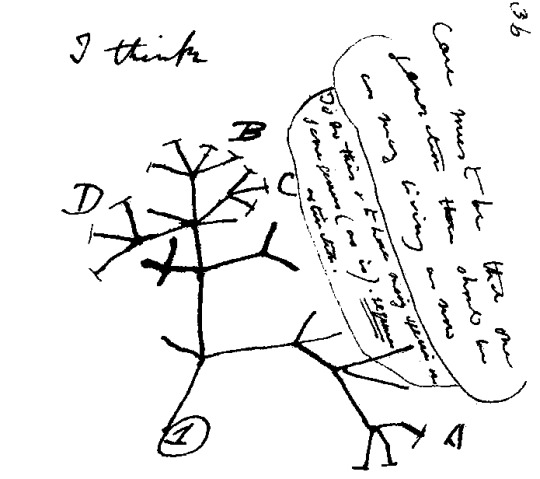
From Wikipedia. Charles Darwin’s first sketch of an evolutionary tree diagram (1837).
Any group of species linked by evolutionary relations is called a taxon (plural taxa). Now, there are many ways to define taxa, but the gold standard is the monophyletic group or clade. Such a group, the only kind held to be valid in cladistics, is composed of the LCA of a certain set of species, all the LCA’s descendants, and nothing else. (See the purple, solid-lined box in the diagram, corresponding to the clade Synapsida, which contains all and only the descendants of the ancestral synapsid.)
Sometimes you want to exclude some of the LCA’s descendants for the purpose of classification. A paraphyletic group is composed of the LCA of a certain set of species and some, but not all, its descendants. The concept of “reptile” is an example: birds are also descendants of the LCA of all reptiles, but they are left out of the group. This is not admitted in cladistics, but it’s not necessarily meaningless: it’s possible for a paraphyletic group to share features that are lacked by the excluded sub-group. For example, “reptiles” generally have scaly skins, teeth, and lack feathers, which is not the case for birds. In such a case, a paraphyletic group can be called a grade. (Other examples of grades are “invertebrates”, “green algae”, “fish”, and “crustaceans”, which exclude vertebrates, land plants, tetrapods, and insects, respectively; or the cyan dashed-lines “mammal-like reptile” box in the diagram, which excludes mammals.)
Finally, we have polyphyletic groups. These are effectively groups with multiple independent origins: they are composed of a certain set of species, but not their LCA. Descriptive terms such as “trees” or “warm-blooded animals” (blue, dotted-line box in the diagram) represent polyphyletic groups. They can be useful, but they do not receive formal names in taxonomy as they do not have definite origins.
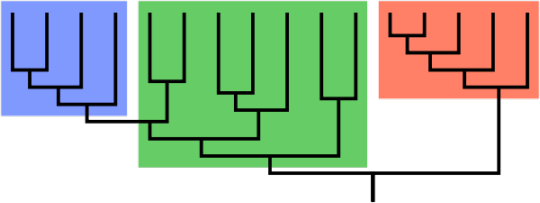
From Wikipedia. The blue and red group are monophyletic and clades, as is the blue + green supergroup; however, the green group on its own is paraphyletic, and may be a grade.
There are two ways to define a clade: an exclusive approach (“the narrowest/most exclusive clade including both the species A and B”) and an inclusive approach (“the broadest/most inclusive clade including the species A but not B”).
A exclusive clade in which the species A and B are both currently living is called a crown group. Aves is such a group (look at the red zone in the diagram), as all the sub-groups that branch from its roots have living members; there is no fully extinct sub-group that is a sister to the rest. It could be defined as “the narrowest possible clade including both ostriches and sparrows”, for example. (In reality, Aves is not a crown group as it includes some basal extinct species, but let’s pretend it does not.)
A total group or pan-group is an extension of a crown group that also includes all extinct species that are closer to it than to any other living species. We could expand Aves to Pan-Aves (the orange zone in the diagram) by defining it as “the broadest possible clade that includes birds but not crocodiles”, crocodiles being the closest still-living relatives of birds.
A stem group is simply the difference of a total group and a crown group: stem-Aves (the yellow zone in the diagram) is the set of all members of Pan-Aves that are not members of Aves, that is, everything that is not a bird whose closest living relative is a bird. “Mammal-like reptiles” could also be described as stem-Mammalia. While crown groups and total groups are monophyletic, stem groups are of course paraphyletic.
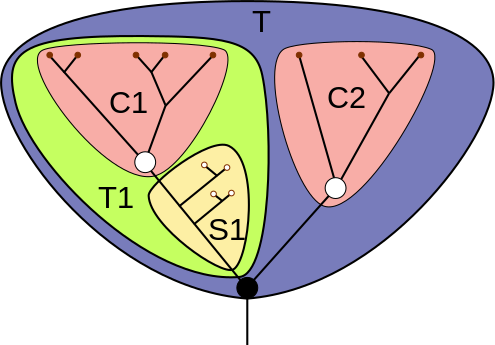
From Wikipedia. Red dots are living species, yellow dots extinct species. C1 and C2 are crown groups; T1 is C1's total group, while S1 is C1's stem group.
Now, symbols I will use to write about present and past taxa. Paraphyletic groups are preceded by an asterisk, e.g. *Nautiloidea. Sometimes I write (*?) or such when the paraphyletic status of a group is uncertain.
Sometimes I provide more than a name for a given group, separated by a slash, e.g. Magnoliophyta/Angiospermae. In some cases the two names are not exactly synonyms, and one might be very slighty more restrictive than the other, but choosing one over the other would not change the scheme I’m showing here.
Quotes surround a name that is no longer used, e.g. “Heliozoa”. I also use quotes to provide translations for some names, e.g. Cyclostomi (“circular mouth”).
As is standard use in taxonomy, the cross-like dagger mark (†) is used to indicate extinct groups, e.g. † Ornithischia. When applied to a paraphyletic group it does not exclude that some descendant species that are not included in it might still exist, e.g. † *Placodermi (which include the ancestors of every living cartilaginous and bony fishes).
9 notes
·
View notes
Text
О бедном киви замолвите слово
Нет, в этой статье речь пойдёт не об экзотическом фрукте, а об очень интересной птице, заметно отличающейся от своих “собратьев” по классу.

У птиц само строение тела и физиология подготовлены к самой важной функции - полёту. Однако киви настолько не приспособлен к полёту и ведёт такой образ жизни, который кажется противоестесственным для птицы вообще.
В книге зоолога Тима Беркхеда (Tim Birkhead) “BIRD SENSE. What It's Like to be a Bird” автор так описывает нашего героя:
“когда птица уже лежит у тебя на коленях, вдруг понимаешь, как диковинно она выглядит. Льюису Кэрроллу понравился бы киви, это воплощенное зоологическое противоречие: больше похож на млекопитающее, нежели на птицу, с роскошным волосовидным оперением, комплектом удлиненных осязательных щетинок и длинным, очень чутким носом”.
Итак, с киви начинаем серию небольших статей, посвященных т.н. бескилевым (Paleognathae) или нелетающим птицам (новонебные и бескилевые разделились на две независимые группы ок. 100 млн. лет назад), к которым относят 5 отрядов из 57 современных видов:
- кивиобразные
- страусообразные
- нандуобразные
- казуарообразные
и тинамуобразные

Моа вымерли к началу XIX века.
Утрата способности к полету и переход к наземному образу жизни - вторичный признак, т.е. ранее эти птицы могли летать, но в связи с изменением условий обитания эволюционно утратили это свойство. Только тинаму способны подняться ненадолго в воздух, но активным полетом это не назовешь. Да, встречаются и другие виды среди птиц, которые тоже не летают (все мы помним про пингвинов), так что у данной группы есть и другая особенность, а именно - строение нёба. А теперь специфическая информация:
Дромеогнатизм: у такого черепа нёбные и крыловидные кости соединены неподвижно, сошник крупный, его передний конец сливается с нёбными отростками костей верхней челюсти, а задний конец расщеплён и соединяется расходящимися концами с нёбными и крыловидными костями. Длина костного нёба в дромеогнатическом черепе неизменна, продольные перемещения сильно ограничены. Неподвижное соединение не позволяет манипулировать с кормом, оно способно только для амортизации толчков и простых хватательных движений. Все бескилевые обладают именно дромеогнатическим типом черепа.
Вот этот рисунок мне очень нравится, он как раз показывает различия в строении черепа между этими двумя большими группами птиц:
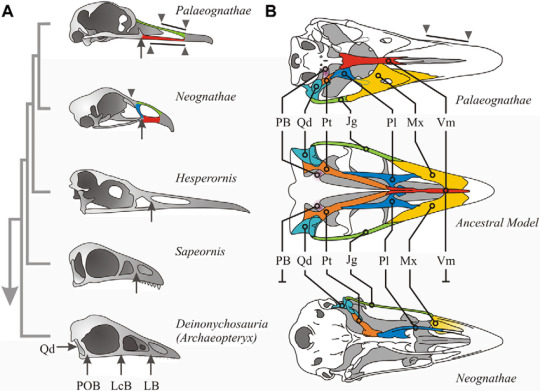
Но вернёмся к нашему киви (лат. Apteryx). Это эндемик Новой Зеландии, включает 5 сохранившихся видов, ареал распространения которых на территории этой страны представлен ниже:
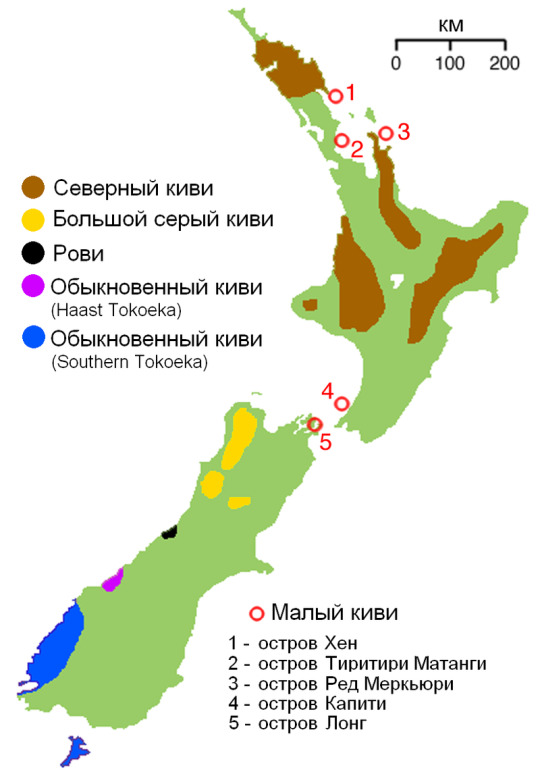
На карте указано 2 подвида обыкновенного киви (A.a. australis Shaw и A.a. lowryi Rothschild), а пятый вид киви, малый или киви Оуэна, встречается только на маленьких островках типа о. Капити.
Киви живут во влажных вечнозеленых лесах и ведут скрытный, преимущественно ночной образ жизни. Днём прячутся в норах или дуплах деревьев.
Эта птица, как я уже писал, не умеет летать но только быстро бегает по земле, постоянно вынюхивая своим длинным клювом, на концах которого расположены ноздри, прячущихся в подлеске насекомых или плоды/семена кустарниковых растений. А вот пьют киви мало. Добытой из фруктов жидкости им вполне хватает, что позволяет им выживать в довольно засушливых районах Новой Зеландии.
youtube
Кстати, своё название киви получили благодаря издаваемым ими звукам “кии-ви-кии-ви��.
youtube
Ночью киви охотятся и обходят свой гнездовой участок, а днём возвращаются в свои глубокие норы, обычно расположенные под корнями деревьев. Вход в такую нору “хозяева” маскируют листьями и травой, а выходов из неё несколько. Самки киви вынашивают всего лишь одно яйцо, однако оно очень крупное и составляет не менее 1/4 от массы взрослой птицы. В последние дни вынашивания киви даже не может есть, т.к. желудок придавливается яйцом к грудной клетке. Однако выполнив свою миссию, самка передаёт эстафету самцу, который занимается насиживаем яйца на протяжении 2,5-3 мес. Птенец рождается с оперением и начинает самостоятельную жизнь, в то время как родители переселяются в другую нору. При такой низкой ответственности неудивительно, что до 90% птенцов погибают в возрасте до 6 мес., становясь жертвами хищников.

Взрослым киви становится к 5 годам, а живёт до 50-60 лет. И это в дикой природе! К сожалению, завезенные человеком кошки, собаки и горностаи значительно сокращают популяцию этих удивительных созданий, 3 вида занесены в “Красную книгу”. На руку хищникам играет и специфический “грибной запах” птиц. Биолог Джим Бриски (Jim Briskie) из Университета Кентербери в Крайстчерче даже наме��евался создать дезодорант специально для киви.
"Down the line, if we do find some species are particularly smelly or vulnerable, perhaps I can design a deodorant for kiwis," he told the Dominion Post newspaper.
Не знаю, увенчалась ли его инициатива успехом или нет.
Напоследок, несколько интересных фактов:
1. Крылья у киви есть, но размеры их составляют всего лишь 4-5 см, и они хорошо скрыты под толстым оперением, напоминающим по структуре шерсть.
2. У киви самая низкая температура среди птиц (средняя тепература у “пернатых” - 42 °C ), и она составляет 38 °C.
3. Киви - рекордсмен по размеру яиц (относительно тела). Кроме того, яйца содержат очень большое количество желтка (до 65%). Это наибольшее содержание желтка среди яиц остальных птиц.
4 - Основной вид чувства у киви - обоняние. Это очень нетипично для птиц, которые обычно полагаются на зрение и слух. Кроме того, у основания клюва располагаются вибриссы, органы осязания, как у многих млекопитающих.
4. У самок киви функционируют оба яичника, для большинства птиц характерен один левый функционирующий яичник.
5. Кости скелета киви не пневматические, т.е. не имеют воздушных полостей.
6. Генетически киви наиболее близок страус эму, а ближайший родственник - вымершая слоновая птица из о. Мадагаскар (Aepyornis maximus), которая достигала в высоту 3 метров при весе до 450 кг. При этом сам киви весит ок. 4 кг.
7. Киви - один из национальных символов Новой Зеландии. Да и самих новозеландцев в шутку называют так.
8. Это фрукт из-за своей формы плодов назван в честь птицы а не наоборот.
Ну и для разгрузки мозгов смотрим клип британского певца Гарри Стайлза (Harry Styles) “Kiwi”:
youtube
Спасибо за внимание! Жду вопросов и предложений в комментах.
15 notes
·
View notes
Photo

The evolution of birds began in the Jurassic Period, with the earliest birds derived from a clade of theropod dinosaurs named Paraves.[1] Birds are categorized as a biological class, Aves. For more than a century, the small theropod dinosaur Archaeopteryx lithographica from the Late Jurassic period was considered to have been the earliest bird. Modern phylogenies place birds in the dinosaur clade Theropoda. According to the current consensus, Aves and a sister group, the order Crocodilia, together are the sole living members of an unranked "reptile" clade, the Archosauria. Four distinct lineages of bird survived the Cretaceous–Paleogene extinction event 66 million years ago, giving rise to ostriches and relatives (Paleognathae), ducks and relatives (Anseriformes), ground-living fowl (Galliformes), and "modern birds" (Neoaves). Phylogenetically, Aves is usually defined as all descendants of the most recent common ancestor of a specific modern bird species (such as the house sparrow, Passer domesticus), and either Archaeopteryx,[2] or some prehistoric species closer to Neornithes (to avoid the problems caused by the unclear relationships of Archaeopteryx to other theropods).[3] If the latter classification is used then the larger group is termed Avialae. Currently, the relationship between dinosaurs, Archaeopteryx, and modern birds is still under debate. (at Pasadena, California) https://www.instagram.com/p/CDo5DM8hoAX/?igshid=8wbvyvtaqtax
0 notes
Photo
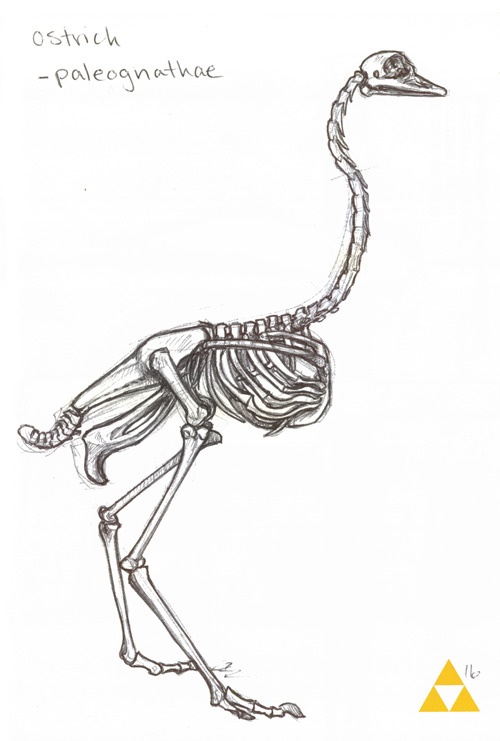
So, crabby and disappointed, I went to read the wikipedia article on bird evolution. And it listed four main groups of modern birds, and I thought I ought to do one of each to get a broader perspective.
“Paleognathae” is one group, made up of stuff like ostriches and emus, mostly flightless birds (though apparently not all; there’s a few birds in this group that can fly, and penguins are in a different group, so it’s not really the defining feature so much as a strong tendency.) Note the relatively small sternum and lack of keel on this flightless bird. Yay I at least understand some things :D
3 notes
·
View notes
Text
Phylum: Chordata
Subphylum: Vertebrata
Class: Aves
Infraclass or superorder: Paleognathae or Galloanserae
5 notes
·
View notes
Video
instagram
. . 🍁🌺 قال رسول الله ﷺ : ينادي مناد إن لكم أن تصحوا فلا تسقموا أبدا وإن لكم أن تحيوا فلا تموتوا أبدا وإن لكم أن تشبوا فلا تهرموا أبدا وإن لكم أن تنعموا فلا تبأسوا أبدا فذلك قوله عز وجل { ونودوا أن تلكم الجنة أورثتموها بما كنتم تعملون } 🍁🌺 . ✔⚪⚫صحيح مسلم⚫⚪✔ . . . 🔴💥طائر النعام - Ostrich🔴💥 . . التصنيف العلمي المملكة : الحيوانية الأسرة في اللغات : الفقاريات شعيبة : الفقاريات الدرجة : إيفس فوق رتبة : Paleognathae الترتيب : Struthioniformes الأسرة : Struthionidae جنس : Struthio الأنواع : S. camelus الاسم العلمي : Struthio camelus . . موطنه الأصلي أفريقيا و جنوب غرب آسيا و يتميز النعام بقوة ساقيه المذهلة حيث يستطيع العدو بسرعة تصل إلى 50 كلم في ساعة وأن يحافظ على سرعته لمدة نصف ساعة و هو الطائر الوحيد الذي له إصبعان في كل قدم و تتغذى على النباتات و الزواحف و وزن بيضها من 1 كلغ و 1,5 كلغ و تتناوب أنثى النعام مع الذكر على احتضان البيض حيث تحتضن الأنثى نهارآ و الذكر ليلا ويفقس البيض بعد 5 أو 6 اسابيع ويعتقد البعض أن فرق فترة حضانة البيض عند النعام تختلف عن بعض الطيور لتمويه في طبيعة المكان من الحيوانات المفترسة حيث ان اغلب الطيور تحضن الانثى البيض في فترة الليل ولاكن في النعام وهو العكس ليساعدها ريشها في التمويه . . Native to Africa and Southwest Asia and is characterized by ostriches strongly amazing legs where the enemy can speed up to 50 kilometers per hour and maintains the speed for half an hour and is the only bird that has two fingers on each foot and feed on plants and reptiles and the weight of their eggs from 1 kg and 1.5 kg, and alternating female ostrich with male incubate the eggs as the female embraces the night and the male at night and the eggs hatch after five or six weeks, and some believe that the period of incubation teams when ostrich differ from some birds to camouflage the nature of the place from predators since most female birds incubating eggs at night time and I was in a contrary ostrich feathers to help her in camouflage . . . . 🍂لا اله الا الله محمد رسول الله صلى الله عليه وسلم There is no god but Allah and Muhammad is the messenger of God🍂 . . . 🍁🌺 قال رسول الله ﷺ : إن للمؤمن في الجنة لخيمة من لؤلؤة واحدة مجوفة طولها ستون ميلا للمؤمن فيها أهلون يطوف عليهم المؤمن فلا يرى بعضهم بعضا 🍁🌺 . ✔⚪⚫صحيح مسلم⚫⚪✔ . . https://www.instagram.com/p/B-Kes6EAAI5/?igshid=5x5uzdit06ze
0 notes
Text
Aves carinatas
"
As aves são uma classe de animais vertebrados, que tem quem como característica básica a presença de penas. Desenvolveram o voo durante o Mesozóico, a partir de uma linhagem de dinossauros. Estudos mostram que as penas evoluíram antes do próprio voo, tendo primeiro a importância para a manutenção de temperatura corpórea, para depois terem função para voo. A classificação taxonômica é controversa, mas alguns estudiosos dividem as aves em dois grupos: Paleognathae (ratitas) que perderam a capacidade de voar e carinatas (Neognathae).
São conhecidas, em torno de 10.000 espécies de aves no mundo todo e no Brasil há registro de mais de 1900 espécies. Graças a sua capacidade de voar, ocupam todos os habitats terrestres, em todos os continentes. As regiões tropicais são as que abrigam a maior diversidade delas.
//<![CDATA[ googletag.cmd.push(function() { googletag.display('dfp-arroba-meio1'); }); //]]>
O pica-pau é uma espécie de ave carinata, pois tem a habilidade de voar. Foto: FJAH / Shutterstock.com
Características
As aves são animais cordados, vertebrados, bípedes, craniados, deuterostômios, alantoidianos, celomados, endotérmicos. Além de pena, possuem bico que varia em formato, conforme o tipo de alimentação da espécie; São pulmonados e têm um órgão chamado siringe (para o canto). A pele tem ausência de glândulas, exceto a uropigiana (produção de substância impermeabilizante para as penas) que aparece em muitas espécies.
As aves carinatas possuem diversas características morfológicas adaptadas para o voo. As asas são membros anteriores modificados para realização dele, têm cerebelo desenvolvido, esterno em forma de quilha, ossos pneumáticos (com cavidades de ar) e sacos aéreos. Não possuem bexiga (tornando-se mais leve para o voo) e excretam ácido úrico junto às fezes. Há presença de membrana nictitante para proteção dos olhos. O olfato é pouco apurado, na maior parte das famílias.
//<![CDATA[ googletag.cmd.push(function() { googletag.display('dfp-arroba-meio2'); }); //]]>
O sistema digestivo tem estruturas específicas como o bico (de queratina e sem dente), papo, proventrículo, moela e no fim a cloaca.
A circulação sanguínea é fechada, sendo que o coração possui quatro câmaras, sem mistura do sangue arterial e venoso. A artéria aorta possui curvatura para direita.
São dioicos, ovíparos, sendo que os ovos possuem casca calcária. A reprodução é sexuada e a fecundação interna. O comportamento reprodutivo varia de espécie para espécie, desde o acasalamento.
As aves usam o voo para se deslocarem, para buscar alimento, fugir de predadores e se reproduzirem. O formato das asas muda conforme o tipo de voo da espécie. As aves sofrem o que chamamos de muda de penas, que é a mudança de suas penas regularmente. A quantidade e a época em que haverá essas trocas, depende da espécie e às vezes, do próprio indivíduo. As penas se dividem em três tipos:
Rêmige- São as penas das asas, que permite a propulsão;
Retrizes- São as penas da cauda, que pode direcionar o voo e auxiliar na decolagem;
Tectrizes- São aquelas que contribuem para a manutenção da camada de ar, na cobertura da pele; os jovens possuem a penuguem.
Aves marinhas possuem glândulas especiais, chamadas de glândulas de sal, que eliminam o excesso de sal ingerido.
Alimentação
Por ser um grupo diverso, a alimentação também é bem variada, abrangendo os frugívoros (frutos, ou semente), nectarívoras, insetívoros, predadores de presa e de carcaça, etc. As aves possuem papéis ecológicos muito importantes, desde a dispersão de sementes, de algumas espécies, ao controle de pragas, como insetos, ou de presas, por predadores como os rapinantes e até da limpeza dos ecossistemas com os carniceiros, como os urubus. As espécies de hábito oportunista acabam lidando bem numa diversidade de habitas, enquanto os especialistas são mais sensíveis aos impactos ambientais.
As aves domésticas representam a maior fonte de proteína para o ser humano, mundialmente.
Conservação
Há declínio de muitas espécies nas últimas décadas, a maior parte das extinções são causadas pela perda de habitat. Além disso, esta classe de vertebrados é a que mais sofre com o tráfico de animais silvestres, sendo que muitas espécies são usadas como pet. As aves são prejudicadas pela poluição, pela caça predatória, colisões em aviões e vidros, entre outras atividades humanas. Espécies invasoras podem ser um problema para espécies nativas, ou mesmo para humanos, como os pombos.
Referências:
Pough, F. H.; et.al. Livro: A Vida dos Vertebrados. 4a edição, editora Atheneu, 2008.
Sick, H.; P. Barruel. Livro: Ornitologia Brasileira. Editora Universidade de Brasília. 1984.
Lista de espécies brasileiras, 2015. Disponível em: http://www.cbro.org.br/PDF/avesbrasil_2014jan1.pdf
Sekercioglu, Cagan Hakki (2006). In: Josep del Hoyo, Andrew Elliott and David Christie. Handbook of the Birds of the World. Barcelona: Lynx Edicions.
RIDGELY, R. S. & TUDOR, G. 1989. The birds of South America. Vol I. University of Texas Press: Austin.
SKUTCH, A. F. 1954. Life histories of Central American Birds. Pacific Coast Avifauna. n° 31. Cooper Ornithological Society: Berkley California.
The post Aves carinatas appeared first on InfoEscola.
InfoEscola https://ift.tt/2H7X6FL Publicado primeiro em https://www.infoescola.com"
Este conteúdo apareceu primeiro em: https://ift.tt/2w0BWWY
0 notes
Text
i know that this website uses the term ‘cursed’ way to liberally but paleognathae are c u r s e d
#Out.#this is the order with most prominent species being kiwi ostriches and emus#that is some high level cursed right there
0 notes
Photo

Tataupa Tinamou (Crypturellus tataupa)
...A species of Tinamou (an order of birds related to the ratites) that inhabits dry subtropical and tropical regions in southeastern South America. As tataupa tinamous are weak fliers they spend most of their lives on the ground and will forage for fruit, leaves, roots, seeds and invertebrates on the forest floor.
Classification
Animalia-Chordata-Aves-Palaeognathae-Tinamiformes-Tinamidae-Tinaminae-Crypturellus-C. tataupa
Image: Dario Sanches
#Tataupa Tinamou#Tinamou#Crypturellus tatupa#Paleognathae#Tinamiformes#South America#Chordata#Aves#Tinamidae#Tinaminae#Crypturellus
219 notes
·
View notes
Photo

Esta es la postalita número 149 del álbum El Zoológico y demuestra a “El Avestruz (Struthio camelus) “Tipo vertebrados. Clase Aves. Corredoras. Rátidas. Fitotagas. Es el ave de mayor tamaño, alas poco desarrolladas, patas muy robustas y desprovistas de plumas, con dos dedos. Vive en terrenos áridos. Las plumas sirven para adornos y producen utilidades. Habitan el África.” Encontramos más información en esta ave Las Rátidas e Inambúes (superorden Paleognathae) en El Zoológico Electrónico en Damisela: El Avestruz (Struthio camelus) es el ave más grande que ha logrado sobrevivir hasta nuestros días. Al igual que las otras aves grandes - los ñandúes, los casuarios y el emú - pertenece al grupo de aves conocido como las rátidas. Estas aves, incluyendo al avestruz, se caracterizan por no poder volar. Se han adaptado a una vida terrestre, las piernas las tienen bien desarrolladas y fuertes. El avestruz macho llega alcanzar los 2.7 metros de altura y pesar 145 Kg. Las largas patas le hacen posible una velocidad de 60 a 70 km/h. Los huevos son blancos y grandes, pesando alrededor de 1.6 Kg. El avestruz habita en las llanuras de África. También se ha establecido como animal salvaje en algunas regiones de Australia. Su carne y sus plumas siempre han sido muy codiciadas, y por tanto cazado hasta la exterminación en algunos lugares. Tanto así, que en el siglo XIX se establecieron granjas en muchas partes del mundo, Sudáfrica y Australia llegando a ser las principales criadoras. Tal implementación dio lugar a razas domésticas. En años recientes ha vuelto a crecer el interés y ahora se usa hasta la piel para cuero de zapatos. La nidada puede tener más de 20 huevos, en la naturaleza se han documentado que han excedido los 70, pero usualmente no nacen más de 20 pichones. El promedio de huevos de la hembra primaria es de unos ocho y es ella quien los acomoda. De alguna forma puede distinguir los propios de los de las otras hembras y los organiza cosa que los suyos se encuentren al centro, de tal forma teniendo mejores posibilidades de lograrse.”
2 notes
·
View notes
Text
The closest relative to the flightless giant birds of the present day.
(There is weird fucking shit going on the cladistics of Paleognathae; it is fucking weird for kiwis to fetch up as next-relative of elephant birds and not as next-relative of moas. At least the two Austalian ratites are each other's next-relative. Flightlessness appears to have evolved separately four to five times, because non-flightless tinamou are nested deeply within the whole Paleognath radiation.)
why do Tinamou eggs look like that. i want to eat them whole
178K notes
·
View notes
Video
instagram
. . النعامة - Ostrich . . التصنيف العلمي المملكة : الحيوانية الأسرة في اللغات : الفقاريات شعيبة : الفقاريات الدرجة : إيفس فوق رتبة : Paleognathae الترتيب : Struthioniformes الأسرة : Struthionidae جنس : Struthio الأنواع : S. camelus الاسم العلمي : Struthio camelus . . موطنه الأصلي أفريقيا و جنوب غرب آسيا و يتميز النعام بقوة ساقيه المذهلة حيث يستطيع العدو بسرعة تصل إلى 50 كلم في ساعة وأن يحافظ على سرعته لمدة نصف ساعة و هو الطائر الوحيد الذي له إصبعان في كل قدم و تتغذى على النباتات و الزواحف و وزن بيضها من 1 كلغ و 1,5 كلغ و تتناوب أنثى النعام مع الذكر على احتضان البيض حيث تحتضن الأنثى نهارآ و الذكر ليلا ويفقس البيض بعد 5 أو 6 اسابيع ويعتقد البعض أن فرق فترة حضانة البيض عند النعام تختلف عن بعض الطيور لتمويه في طبيعة المكان من الحيوانات المفترسة حيث ان اغلب الطيور تحضن الانثى البيض في فترة الليل ولاكن في النعام وهو العكس ليساعدها ريشها في التمويه . . Native to Africa and Southwest Asia and is characterized by ostriches strongly amazing legs where the enemy can speed up to 50 kilometers per hour and maintains the speed for half an hour and is the only bird that has two fingers on each foot and feed on plants and reptiles and the weight of their eggs from 1 kg and 1.5 kg, and alternating female ostrich with male incubate the eggs as the female embraces the night and the male at night and the eggs hatch after five or six weeks, and some believe that the period of incubation teams when ostrich differ from some birds to camouflage the nature of the place from predators since most female birds incubating eggs at night time and I was in a contrary ostrich feathers to help her in camouflage . . . ❤لا اله الا الله محمد رسول الله صلى الله عليه وسلم There is no god but Allah and Muhammad is the messenger of God❤ . . . . 🍁 عن عبد الله بن زيد المازني رضي الله عنه أن رسول الله صلى الله عليه وسلم قال ما بين بيتي ومنبري روضة من رياض الجنة 🍁 . 🌺🌹 رواه البخاري - 1137 🌺🌹 . . . . . قران - Quran . . . @bosaif_aldhaheri @bosaif_aldhaheri @bosaif_aldhaheri . . (((أَشْهَدُ أَنْ لاَ إِلَهَ إِلاَّ اللَّهُ.أَشْهَدُ أَنَّ مُحَمَّدًا رَسُولُ))) (((I bear witness that there is no God but Allah and that Muhammad is His servant/slave and His messenger))) . .
0 notes
Text
Aves ratitas
"
As aves são uma classe de animais vertebrados, que tem quem como característica básica a presença de penas. Desenvolveram o voo durante o Mesozóico, a partir de uma linhagem de dinossauros. Estudos mostram que as penas evoluíram antes do próprio voo, tendo primeiro a importância para a manutenção de temperatura corpórea, para depois terem função para voo. São conhecidas, em torno de 10.000 espécies de aves no mundo todo. Graças a sua capacidade de voar, ocupam todos os habitats terrestres, em todos os continentes. As regiões tropicais são as que abrigam a maior diversidade delas.
As aves ratitas não possuem o esterno em forma de quilha, sendo achatado, além de serem geralmente pesados e possuírem asas pequenas e atrofiadas, usadas para o direcionamento, enquanto correm. Isso determina a incapacidade de voo nesses animais. Porém, são excelentes corredoras, já que, geralmente possuem pernas longas e mudanças morfológicas em seus pés que melhoram o contato com o solo, como os artelhos voltados para frente, além da sua diminuição, como no caso do avestruz, que só tem dois artelhos em contato com o chão.
//<![CDATA[ googletag.cmd.push(function() { googletag.display('dfp-arroba-meio1'); }); //]]>
Características
As aves são animais cordados, vertebrados, bípedes, craniados, deuterostômios, alantoidianos, celomados, endotérmicos. Além de pena, possuem bico que varia em formato, conforme o tipo de alimentação da espécie; São pulmonados, a pele tem ausência de glândulas, exceto a uropigiana (produção de substância impermeabilizante para as penas) que aparece em muitas espécies.
O sistema digestivo é constituído de bico (de queratina e sem dente), papo (onde se armazena o alimento ingerido), moela (onde ficam as pedras ingeridas que ajudam a moer o conteúdo ingerido) e no fim do canal tem a cloaca, usada também na reprodução.
//<![CDATA[ googletag.cmd.push(function() { googletag.display('dfp-arroba-meio2'); }); //]]>
A circulação sanguínea é fechada, sendo que o coração possui quatro câmaras, sem mistura do sangue arterial e venoso. A artéria aorta possui curvatura para direita.
São dioicos, ovíparos, sendo que os ovos possuem casca calcária. A reprodução é sexuada e a fecundação interna. O comportamento reprodutivo varia de espécie para espécie, desde o acasalamento.
A classificação taxonômica é controversa, mas alguns estudiosos dividem as aves em dois grupos: Neognathae (carinatas) e Paleognathae, que perderam a capacidade de voar. Paleognathae é composto por Tinamiformes (aves endêmicas da região neotropical, que têm aparência parecida com galináceo), que fazem voos muito curtos; e ratitas que não voam.
São quatro ordens: Emu e casuar (ordem Casuariiformes), ema (ordem Rheiformes), avestruz (ordem Struthioniformes) kiwis (ordem Apterygiformes ).
Reprodução
São nidífugas, ou seja, seus filhotes nascem bem desenvolvidos e já com habilidade para dispersar do ninho. Os avestruzes são africanos, as fêmeas botam seus ovos no chão, em ninhos comunitários e chocam revezando com os machos. É o maior ovo de uma ave viva.
A Ema (presente na América do Sul) é a maior ave brasileira e os machos são responsáveis pela incubação e cuidado com os filhotes.
Rhea americana (Ema), uma ave ratita. Foto: Rosalba Matta-Machado / Shutterstock.com
Os Kiwis (nativos da Nova Zelândia), apesar de serem os menores das aves ratitas, botam o maior ovo, em proporção ao seu tamanho. São monogâmicos e ambos chocam um único ovo, por estação reprodutiva.
O Emu é encontrado na Austrália e também tem o macho incubando os filhotes, chegando a ficar dias e dias sem se alimentar, no cuidado com o ninho.
O Casuar é encontrado na Austrália, Nova Zelândia e ilhas por perto. O macho prepara o ninho, as fêmeas frequentam, copulam e botam seus ovos, deixam os machos cuidando e partem para novos ninhos.
Alimentação
No geral, são animais onívoros, alimentando-se de folhas, frutos, invertebrados e até pequenos vertebrados. No caso do Kiwi, são mais especialistas, procurando apenas invertebrados.
Referências:
Storer, Traci i. et al. Zoologia Geral. 6ª ed. São Paulo. Companhia Editora Nacional, 2007.
Pough, F. H.; et.al. Livro: A Vida dos Vertebrados. 4a edição, editora Atheneu, 2008.
Sick, H.; P. Barruel. Livro: Ornitologia Brasileira. Editora Universidade de Brasília. 1984.
The post Aves ratitas appeared first on InfoEscola.
InfoEscola https://ift.tt/2Z8GVy6 Publicado primeiro em https://www.infoescola.com"
Este conteúdo apareceu primeiro em: https://ift.tt/2w0BWWY
0 notes